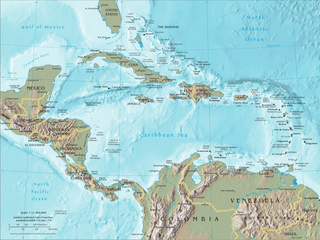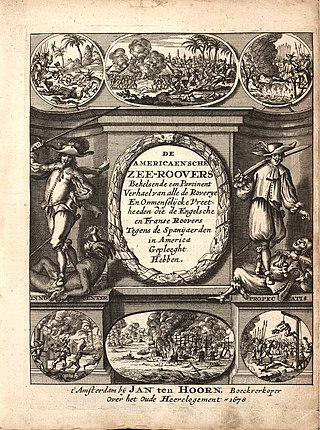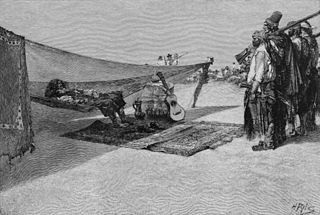Related Research Articles

Buccaneers were a kind of privateer or free sailors particular to the Caribbean Sea during the 17th and 18th centuries. First established on northern Hispaniola as early as 1625, their heyday was from the Restoration in 1660 until about 1688, during a time when governments in the Caribbean area were not strong enough to suppress them.

The era of piracy in the Caribbean began in the 1500s and phased out in the 1830s after the navies of the nations of Western Europe and North America with colonies in the Caribbean began hunting and prosecuting pirates. The period during which pirates were most successful was from the 1660s to the 1730s. Piracy flourished in the Caribbean because of the existence of pirate seaports such as Port Royal in Jamaica, Tortuga in Haiti, and Nassau in the Bahamas. Piracy in the Caribbean was part of a larger historical phenomenon of piracy, as it existed close to major trade and exploration routes in almost all the five oceans.

Tortuga Island is a Caribbean island that forms part of Haiti, off the northwest coast of Hispaniola. It constitutes the commune of Île de la Tortue in the Port-de-Paix arrondissement of the Nord-Ouest department of Haiti.

Alexandre Olivier Exquemelin was a French, Dutch, or Flemish writer best known as the author of one of the most important sourcebooks of 17th-century piracy, first published in Dutch as De Americaensche Zee-Roovers, in Amsterdam, by Jan ten Hoorn, in 1678.

The Golden Age of Piracy is a common designation for the period between the 1650s and the 1730s, when maritime piracy was a significant factor in the histories of the North Atlantic and Indian Oceans.

Roche Braziliano was a Dutch Brazilian pirate born in the town of Groningen. His pirate career lasted from 1654 until his disappearance around 1671. He was first made famous in Alexandre Exquemelin's 1678 book The Buccaneers of America; Exquemelin did not know Braziliano's real name, but historians have found he was probably born as Gerrit Gerritszoon and that he and his parents moved to Dutch-controlled Brazil. He is known as "Roche Braziliano", which in English translates to "Rock the Brazilian", due to his long exile in Brazil.

The Brethren or Brethren of the Coast were a loose coalition of pirates and buccaneers that were active in the seventeenth and eighteenth centuries in the Atlantic Ocean, Caribbean Sea, and Gulf of Mexico. They mostly operated in two locations, the island of Tortuga off the coast of Haiti and in the city of Port Royal on the island of Jamaica.
Anne "Dieu-Le-Veut" de Graaf also called Marie-Anne or Marianne was a French pirate. Alongside Jacquotte Delahaye, she was one of very few female buccaneers. While Delahaye was likely fictional, Dieu-le-Veut was real; however, many of her exploits are inventions of later writers.

Fort de Rocher was a seventeenth-century fortress on the Caribbean island of Tortuga, northwest of Haiti. It was built and utilized by buccaneers as the primary defense of the island to prevent encroachment of Spanish forces. The fortress lies in ruin today, with only the foundations remaining.
This timeline of the history of piracy in the 1640s is a chronological list of key events involving pirates between 1640 and 1649.
This timeline of the history of piracy in the 1670s is a chronological list of key events involving pirates between 1670 and 1679.
This timeline of the history of piracy in the 1650s is a chronological list of key events involving pirates between 1650 and 1659.

Daniel Montbars (1645–1707?), better known as Montbars the Exterminator, was a 17th-century French buccaneer. For several years, he was known as one of the most violent buccaneers active against the Spanish during the mid-17th century. His reputation as a fierce enemy of the Spanish Empire was matched only by François l'Olonnais and Roche Braziliano.

Edward Mansvelt or Mansfield was a 17th-century Dutch corsair and buccaneer who, at one time, was acknowledged as an informal chieftain of the "Brethren of the Coast". He was the first to organise large scale raids against Spanish settlements, tactics which would be utilised to attack Spanish strongholds by later buccaneers in future years, and held considerable influence in Tortuga and Port Royal. He was widely considered one of the finest buccaneers of his day and, following his death, his position was assumed by his protégé and vice-admiral, Henry Morgan.

Pierre le Picard (1624–1690?) was a 17th-century French buccaneer. He was both an officer to l'Olonnais as well as Sir Henry Morgan, most notably taking part in his raids at Maracaibo and Panama, and may have been one of the first buccaneers to raid shipping on both the Caribbean and Pacific coasts.

The Capture of Fort Rocher took place on 9 February 1654, during the Franco-Spanish War (1635–1659). Equipped with one siege battery, a Spanish expedition of 700 troops attacked the buccaneer stronghold of Tortuga, capturing the Fort de Rocher and 500 prisoners including 330 buccaneers and goods valued at approximately 160,000 pieces-of-eight. The Spanish burned the colony to the ground and slaughtered its inhabitants, leaving behind a fort manned by 150 soldiers. They possessed the island for about eighteen months, but on the approach of the expedition under Penn and Venables were ordered by the Conde de Peñalva, Governor of Santo Domingo, to demolish the fortifications, bury the artillery and other arms, and retire to his aid in Hispaniola.
James Browne was a Scottish pirate and privateer active in the Caribbean. He is best known for his hasty execution and its effect on colonial Jamaican government.

The 1635 Capture of Tortuga was a successful military campaign against the Anglo-French plantation, pirate, and buccaneering settlement of Tortuga, then a dependency of the Providence Island colony. It resulted in heavy casualties for the settlement, the severance of Tortuga's link with Providence Island, and Tortuga's further shift towards piracy and buccaneering.
References
- ↑ Konstam, Angus. Pirates: Predators of the Seas. New York: Skyhorse Publishing, 2007. (pg. 25) ISBN 1-60239-035-5
- ↑ Lane, Kris E. Pillaging the Empire: Piracy in the Americas - 1500-1750. London: M.E. Sharp, 1998. (pg. 102) ISBN 0-7656-0256-3
- ↑ Osler, William. An Alabama Student and Other Biographical Essays. Oxford: Clarendon Press, 1908. (pg. 19)
